How Mussolini's East African Empire died
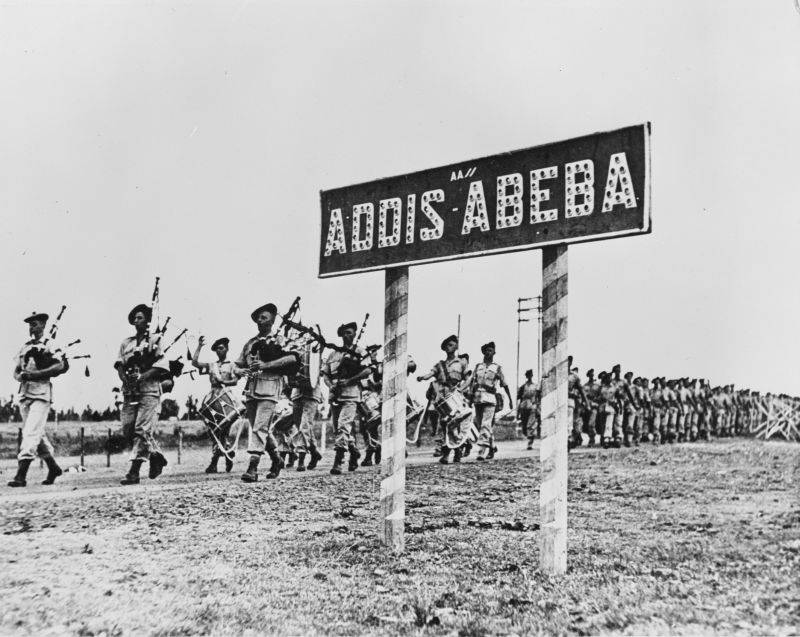
Scottish soldiers walk along the road in the Addis Ababa area
General situation
In 1935-1936, Italy invaded Ethiopia and created the Italian East Africa colony. It also included Eritrea and Italian Somalia. In June 1940, fascist Italy entered World War II. Initially, the Italians had an overwhelming superiority in forces: about 90 thousand soldiers, plus native troops - up to 200 thousand people, over 800 guns, more than 60 tanks, more than 120 armored vehicles, 150 aircraft.
England had only about 9 thousand people in Sudan, 8,5 thousand in Kenya, about 1,5 thousand in British Somalia, and 2,5 thousand soldiers in Aden. In Sudan, Kenya and Somalia, the British had 85 aircraft and no tanks or anti-tank artillery. To neutralize the enemy's superiority, England formed an alliance with the emigrant Ethiopian Emperor Haile Selassie. A massive national liberation movement began in Ethiopia. Many soldiers from the colonial forces deserted and went over to the side of the partisans.
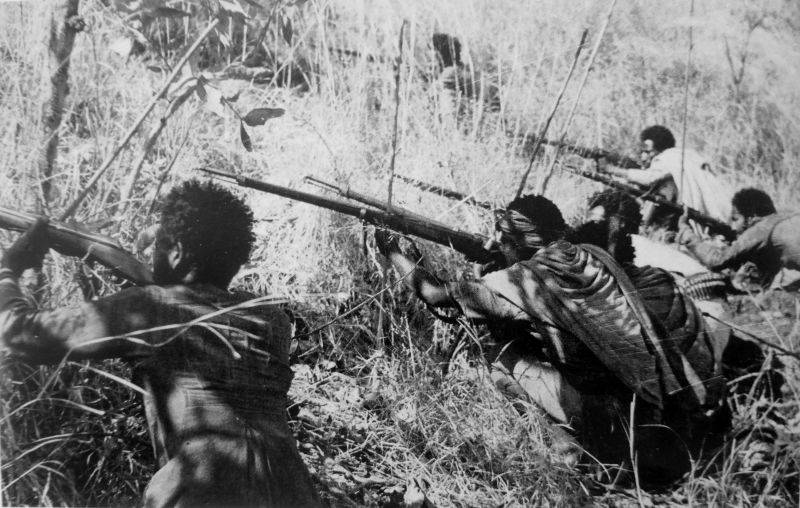
Ethiopian guerrillas attack Fort Debra Marcos. 1940 g.
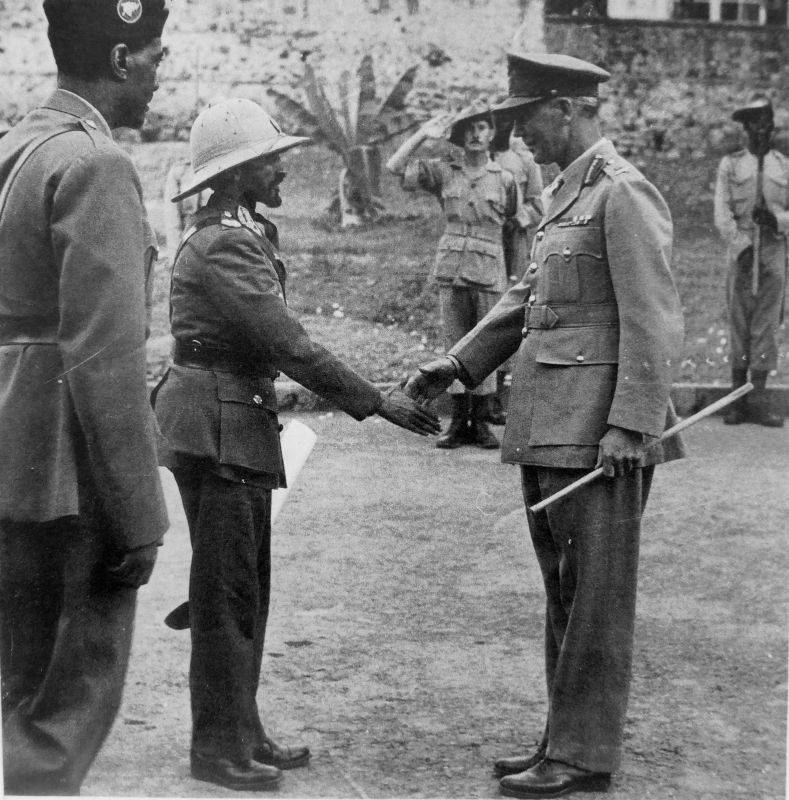
Emperor of Ethiopia H. Selassie at a meeting with British General A. Cunningham in Addis Ababa. 1941 g.
If there were Germans instead of Italians, it is obvious that they used a great advantage in the Mediterranean, in North and East Africa, to defeat the British. Italy was well placed to capture Malta, the British air and naval base in the central Mediterranean, which was then garrisoned weakly. Win air supremacy with an advantage over the British Air Force during the air battle for England. To occupy Egypt with a swift blow, to advance to the Suez Canal, then the entire Mediterranean Sea would be in Italian hands, a connection with East Africa would be established.
That is, the Italians had a good chance of wresting the Mediterranean and all of Northeast Africa from the British rule. Especially with the support of the Germans. However, Rome had no strategy, no will, and no determination. The situation demanded quick and assertive action until the enemy came to his senses.
Mussolini and the Italian command feared decisive action by all means, deciding to confine themselves to private operations. Two sole motorized divisions and two armored divisions were left in Italy, although they were best used in Africa to push towards the Suez. The Italians justified themselves by the fact that their sea communications were stretched, and the British could block them, disrupting the supply of the Italian group in East Africa.
And the native (colonial) troops, more than 2/3 of all forces, were poorly armed and prepared. In addition, in occupied Ethiopia, the guerrillas again became active, who were now supported by the British. In most provinces, the Italians controlled only cities and large settlements where garrisons were stationed. Some distant units were blocked by the rebels, and their supply went only by air. All this limited the operational capabilities of the Italian army and fettered the decisiveness of the command.
In July 1940, the Italian army launched an offensive from Eritrea and Ethiopia deep into Sudan and Kenya. In Sudan, Italian troops managed to occupy the border towns of Kassala, Gallabat and Kurmuk, and their successes were limited to this. In Kenya, the border Moyale was occupied. The Italian command did not dare to develop an offensive and went on the defensive in the Sudanese and Kenyan directions. It was decided to strike at British Somalia, where the British had minimal strength. The Italians concentrated 35 thousand groups and in August 1940 captured the British colony. British African and Indian colonial units were taken to Aden.
The loss of the initiative by the Italians and the build-up of the British group
After small successes in Sudan and victory in Somalia, the Italian army, led by Viceroy and Commander-in-Chief Amadeus of Savoy (Duke of Aosta), decided to wait for the decisive success of the Italian forces in North Africa.
The capture of Egypt and Suez solved the supply problem. Then two groups of Italian troops from the north (Egypt) and from the south could achieve victory in Sudan and unite. However, the Italians in Libya made a number of mistakes, acted hesitantly and did not use the opportunity to defeat the weak enemy grouping in Egypt. The Italians occupied the territory, but did not defeat the enemy (Italian invasion of Somalia and Egypt).
The British made good use of the time given to them. Despite the problems associated with a possible German strike, the British reinforced their forces in Egypt with tanks and modern fighters. Reinforcements were transferred to Malta. New ships (aircraft carrier, battleship, air defense cruisers) arrived in Egyptian Alexandria, which strengthened the defense of the naval base. New units arrived in Egypt, Kenya and Sudan from England, India, Australia and New Zealand. Military districts (commands) were created on the territory of British Africa, which formed and trained new colonial units. In a short time, 6 infantry brigades (including 2 reinforced) were formed in East Africa and 5 in West.
From the natives, units and auxiliary units of the army of the South African Union were formed. A large number of native support and service units became part of the British formations. In the fall of 1940, the British already had 77 people in Kenya, of which more than half were Africans. In Sudan, the group consisted of 28 thousand people, and 2 more Indian infantry divisions were sent there. By the beginning of 1941, British troops and partisans had completely cleared the lost territories in northwestern Kenya from the enemy.
In late 1940 - early 1941, British troops inflicted a crushing defeat on the Italian army in Libya (Catastrophe of the Italian army in North Africa). The British took Tobruk, Benghazi, the western part of Cyrenaica. The Italian group in North Africa, in fact, was destroyed, only about 130 thousand people were taken prisoner, almost all heavy weapons were lost. Having eliminated the threat in the north, the British began to destroy the Italian forces in East Africa.
As a result, the Italian troops isolated from the metropolis, lacking ammunition, fuel and spare parts for a few aircraft, tanks and armored cars, were doomed to defeat. The Ethiopian liberation movement played a large role in the collapse of Italian East Africa. The Italians still had a numerical superiority, but their forces were scattered, fought against an internal enemy - the rebels. The British were able to concentrate several strike groups.
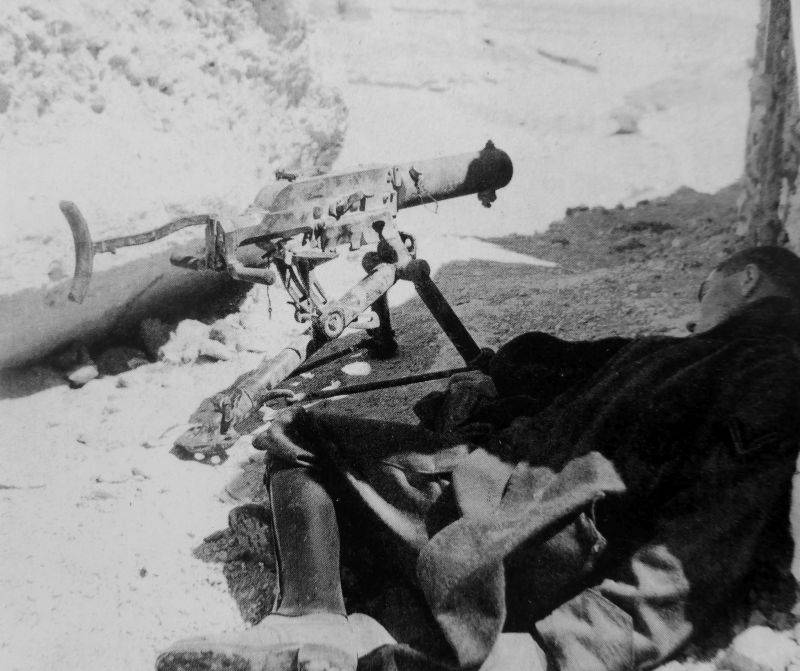
An Italian machine gunner sleeps in the shadows near the city of Berbera in the Italian-occupied part of British Somalia. Next to him is the Schwarzlose MG Schwarzlose 07/12 heavy machine gun
The defeat of the Italian army
In Sudan and Kenya, 150 thousand groups were concentrated (mainly colonial units).
On January 19, 1941, on the border of Italian Eritrea, the British-Indian and Sudanese troops launched an offensive - 2 divisions and 2 motorized groups. The offensive was supported by the Free French units. The main target of the offensive was Massawa, the colony's only port on the Red Sea. In early February, African troops launched an offensive from Kenya (1st South African, 11th and 12th African divisions). They attacked Ethiopia and Italian Somalia. The movement of the motorized brigade along the coast was to play a decisive role. Mixed Sudanese-Ethiopian troops and partisans entered Ethiopia from the west. Sudanese, East African troops and colonial units from the Belgian Congo operated from the southwest.
The regular Ethiopian units that entered Ethiopia became the nucleus of a large army. The Ethiopian army numbered about 30 thousand people, and the total number of rebels and partisans ranged from 100 thousand to 500 thousand. Having liberated this or that territory, almost all the rebels returned to peaceful life. By April 1941, the Ethiopian army liberated the province of Gojam.
70 thousand Italian group in Eritrea by the beginning of the enemy offensive was already exhausted by the fight against the rebels and could not offer serious resistance. On February 1, the British occupied Agordat. The Italians retreated to the Keren area, which had good natural fortifications. This city was of strategic importance, covering the capital of Asmara and the port of Massawa. While British forces were blockading Keren, Ethiopian guerrillas intercepted a road heading north from Addis Ababa. The Italian troops in Keren lost the main road along which they received reinforcements and supplies.
The Italians repulsed the first attacks of Indian infantry brigades on Keren. The commander of the British forces, William Plett, took a break. Meanwhile, units of the 4th Indian Division and Free French battalions began an offensive from the north. On March 15, a new offensive began on Keren. Only by March 27, the British were able to break the enemy's resistance. In early April, British forces occupied Asmara and Massawa. British troops from Eritrea moved to Northern Ethiopia, to Ambu Alagi and Gondar.
British-African troops, which were advancing from Kenyan territory in Italian Somalia and South Ethiopia, were opposed by up to 5 Italian divisions (40 thousand soldiers) and a large number of native detachments. 22 thousand Italian grouping occupied a defensive line on the Juba River in Somalia and to the north of it. After two weeks of fighting (February 10-26, 1941), the Italian defenses fell.
The enemy crossed the river in several places and went to the rear of the Italians. African troops captured the port of Kismayu, several important airfields and bases, the cities of Jumbo, Dzhelib and moved to Mogadishu. Local natives rebelled against the Italians. Mogadishu fell on 26 February. Italian troops first rolled back to Hararu in eastern Ethiopia, then to Addis Ababa. African divisions from Somalia turned to Ethiopia, to Harar and Addis Ababa.
On March 10-16, 1941, the British landed troops at Berbera in former British Somalia. This was the first successful Allied landing operation during the Second World War. They occupied the British colony in a few days. The Italians did not offer serious resistance. The Allies now had a supply base at Port Berber.
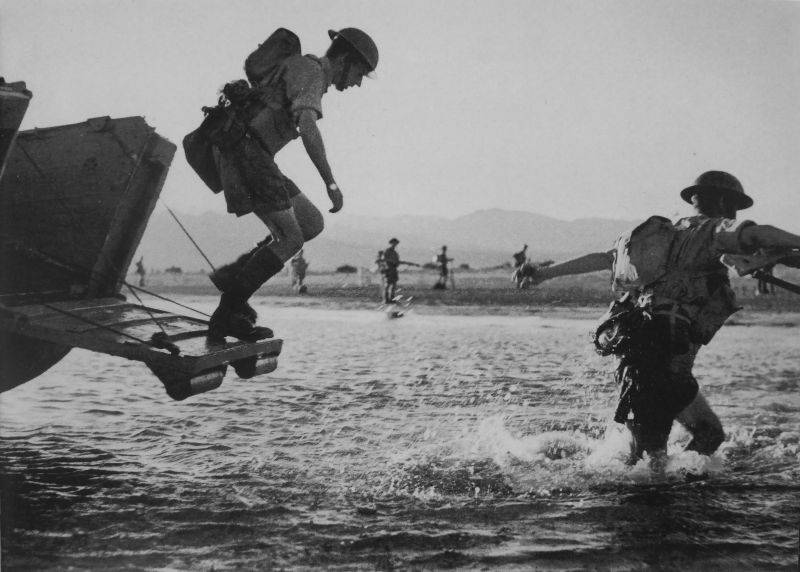
A British Army unit lands near Berbera. March 1941
Fall of Addis Ababa and Amba Alagi
The defeat of groups in Somalia and Eritrea, their loss (as well as a significant part of weapons, technology), a large-scale uprising of the Ethiopians, deprived the Italian command of hopes of holding back the enemy offensive. There was no strength to hold out in the eastern and central parts of Ethiopia. Therefore, the Italians practically did not resist the British in the east and even asked them to occupy the capital as soon as possible. In the western direction, the Italians, as best they could, held back the Ethiopian troops. On March 17, 1941, the British occupied Jijiga.
Next, it was necessary to overcome the Marda mountain pass, which is very convenient for defense. To their surprise, the British met no resistance. On March 25, Harar, the second city of Ethiopia, was occupied without a fight. On April 6, 1941, British colonial forces entered Addis Ababa. Several Ethiopian guerrilla groups, fighting their way through the mountains, entered the capital almost simultaneously with the British.
Fulfilling the direction of the rate - to fetter the forces of the enemy as much as possible, the Italians continued their resistance in the remote mountainous regions of the country: in the north - near Gondar, in the northeast - in Dessie and Amba-Alagi, in the south-west - in Jimma. The group of forces of the commander-in-chief Amadeus of Savoy retreated from Addis Ababa in Amba Alag, where it joined up with part of the group that had retreated from Eritrea. The group of General Pietro Gazzera (Gadzera) withdrew to the south of Ethiopia (in the provinces of Sidamo and Galla), and the troops of General Guglielmo Nasi to Gondar.
The last enemy lines were stormed by the 11th and 12th African infantry divisions, Sudanese, Congolese units, regular and partisan forces of Ethiopia. In the north, Indian units took part in the battle. On April 17, an offensive began on the group of the Prince of Savoy. On April 25, Dessie fell, the British laid siege to Amba-Alage. The Italians, taking advantage of the inaccessible terrain, fought hard. Only at the cost of heavy losses was the enemy's defense broken. Lacking food and water, on May 18, 1941, the Italians, led by Duke Aosta, surrendered. Most of northern Ethiopia was liberated from the Italians.

Indian troops during the Battle of Amba Alag. May 1941
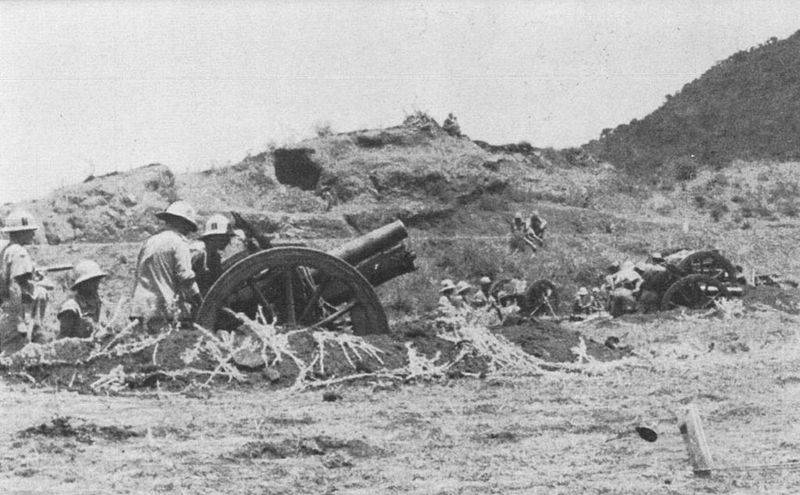
British artillery at the Battle of Amba Alag
General Gazzer became the acting viceroy and commander-in-chief. Stubborn battles were fought in the province of Galla Sidamo. The 11th Allied Division was advancing from the north, from the capital, the 12th Division - from the south. Jimma fell on June 21st. The general resisted for some time, switching to partisan tactics, and surrendered in July. In the southwest, 25 thousand people were captured.
The last stronghold of the Italians was Gondar. Under the command of General Nasi, there was a fairly large group of troops - 40 thousand soldiers (battalions of black shirts - fascist militia, colonial troops and several cavalry squadrons). From May 17 to November 1941, the Allies sequentially took several enemy strongholds. The Italians put up stubborn resistance, their best units were destroyed in battle. So, during the fierce battles for Kulkvalber, his garrison was killed - the first group of mobile carabinieri and the 240th battalion of blackshirts. The indigenous units, not receiving salaries and provisions, practically fled. On November 28, Nasi surrendered. Over 12 thousand Italians were killed and injured.
For Italians, the loss of their colonial empire in East Africa, including Ethiopia, which was captured several years ago at the cost of heavy losses, was very painful. The remnants of the Italian army (several thousand people) fought in Eritrea, Somalia and Ethiopia until the fall of 1943. They hoped that the German-Italian troops under the command of Rommel would win in Egypt and this would allow the return of the Italian colonies in East Africa.
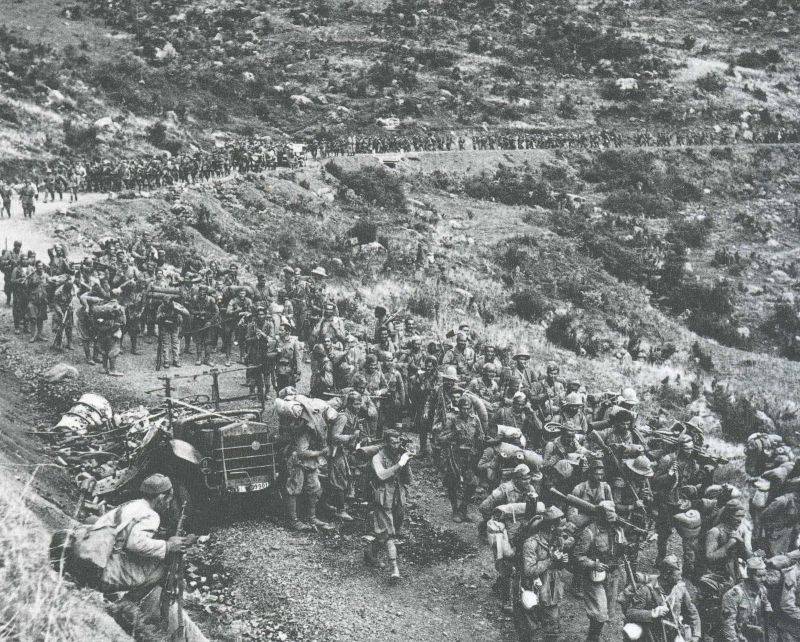
The Italians surrender after the surrender of the Amba Alagi stronghold in Ethiopia. May 1941
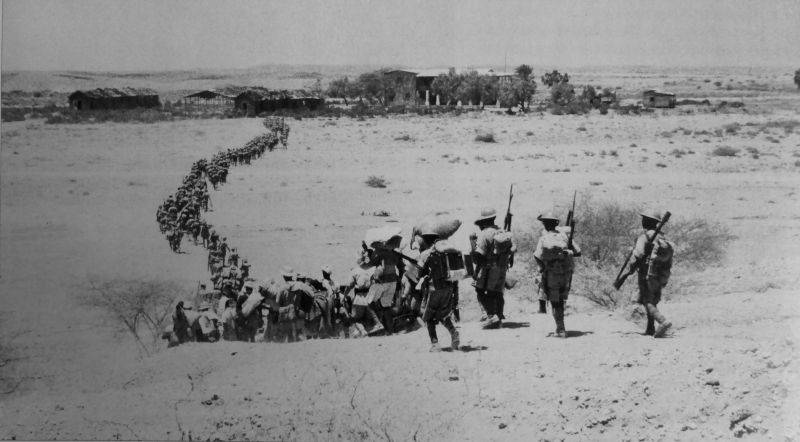
Soldiers of a part of the colonial troops of the British army escort Italian prisoners of war in the area of Fort Umberto in Ethiopia
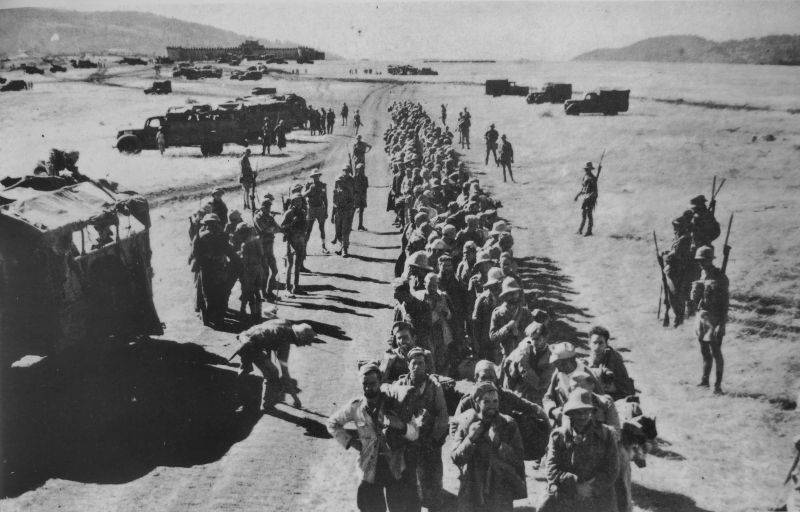
Italian prisoners of war guarded by British soldiers on their way from South Ethiopia to a camp in Kenya. July 1941
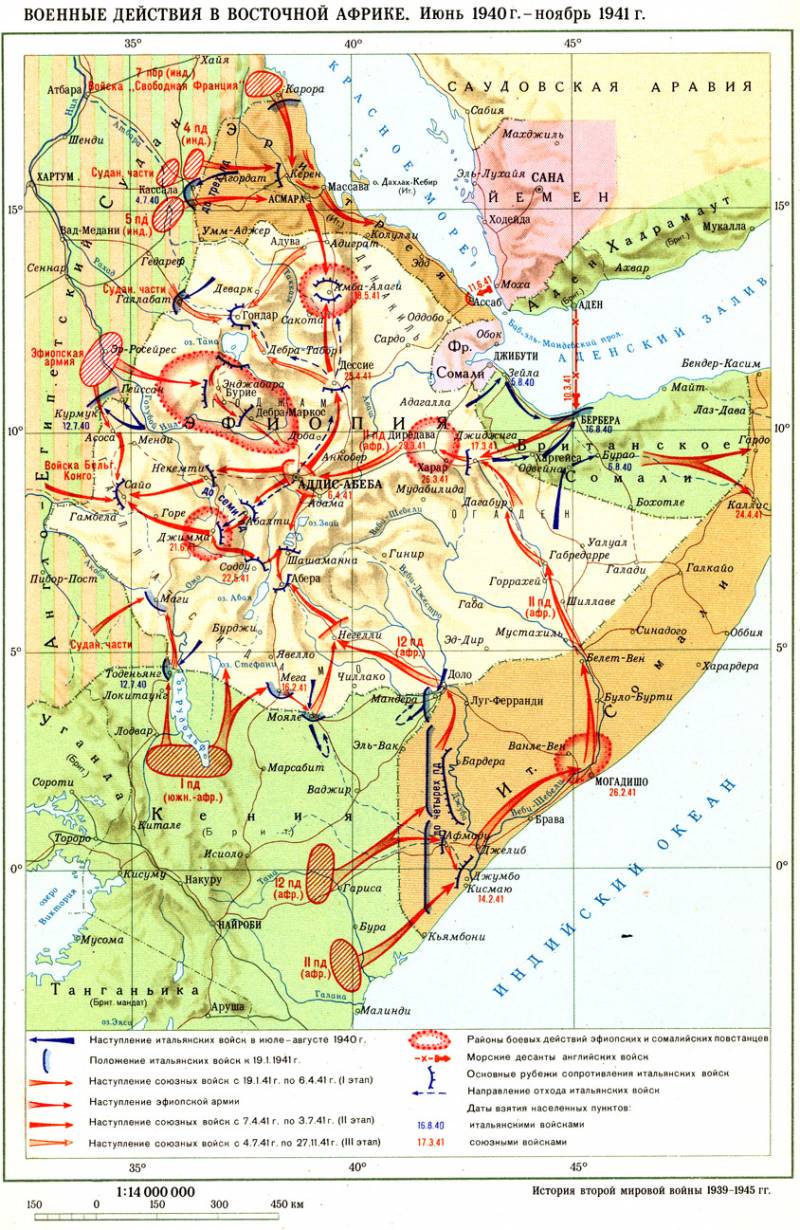
Information